Repost from Bird watching on Curaçao in November – Bird Watching Curaçao – HOME
This post is also available in: Dutch (below)
Bird watching on Curaçao is a surprise throughout the year. The island may be small (444 square kilometers or +/- 171.4 square miles), but has many small habitats spread out from the east to the west. Even in the inner city of Unesco World Heritage Willemstad, there are many areas where a bird can hide, eat, nest or just rest. Which makes every corner of the island potentially interesting for birders.
November usually marks the end of the masses of migratory birds passing through the many habitas of the island, but that doesn’t mean there will be no surprises left. Time has told us that the month of November sometimes provides with incredible sightings of rare species and even new species to the island. It might pay off to visit and revisit certain areas on the island regularly to keep track of the bird diversity there. Think of areas such as the RAMSAR area of Muizenberg dam. This dam doesn’t fill up completely every year, it depends on the amount of rain falling in the rainy season. Usually the area contains water puddles that attract a lot of terrestrial and shorebirds. If rainfall is more extensive in the direct area, chances are that the dam will fill up completely transforming into a fresh water pond that also attracts a variety of waterbirds. The same counts for other dams and gullies on the island.
Territorial Fights in White-Tailed Hawks
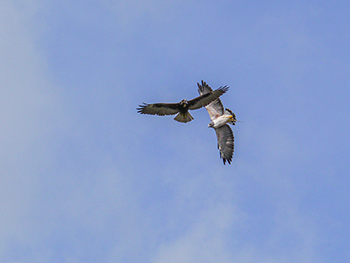
The White-Tailed Hawk (Geranoaetus albicaudatus) is one of the rarest breeding birds in our airspace and is becoming increasingly rare on Curaçao due to habitat destruction. During these last months of the year, territorial fights will be more common, primarily between adults and young birds seeking their own territory. The parents will actively chase off their own offspring, which are already self-sufficient, out of the territory to create enough space for the next brood. This is essential, as the territory must provide sufficient food to feed the new nest. In areas where these birds occur, it’s important to keep a close eye out for these territorial fights while hiking; it’s definitely worth taking the time. A live-action documentary.
Calling loudly with their characteristic high-pitched screeches, the birds will circle each other and stage mock attacks. Usually, it’s the adult bird, recognizable by its dark head and white belly, that performs the mock attack on the younger bird, which is completely dark. If this doesn’t impress the young bird enough to actually chase it away, the mock attacks can escalate into real attacks, with the attacker using its feet and beak to try and overpower the other. If this succeeds, and the young bird flies away, the fight is over. If this doesn’t work, the fight will continue until one of the two gives up. If it’s the adult bird, the territory will be taken over by the younger bird, and the adult will likely die.
Incidentally, it’s not always the bird’s own offspring that tries to take over the parents’ territory. Usually, it’s young birds from other pairs searching for a spot for themselves, thus causing the fights. The adult bird in the photo has just caught prey. A lizard is clenched in the bird’s talons.
Special Bird Visitors
Most of the autumn migration, when thousands of birds from North America fly to the warm south and sometimes visit the island, is behind us. But November is ideal for the arrival of ducks. They are often the last to arrive. And even here, most only stay for a few days and then move on. Only a few remain on the island for the winter. Besides ducks like the Ring-necked Duck other bird species can also be found such as the Prothonothary warbler and the fastes bird on Earth; the Peregrine falcon.
The Peregrine Falcon or Falco peregrinus
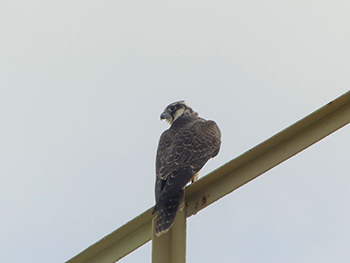
The fastest bird in the world is the Peregrine Falcon, and this beautiful species can also be found on Curaçao, primarily during the winter months. Recognizable by its streamlined wings and extremely fast flight. They are especially spotted in places where parrots and parakeets gather to roost, or in places where many (city) pigeons are found. These are ideal hunting grounds for these magnificent animals.
The Prothonotary Warbler or Protonotaria citrea

Fast and shy, the perfect combination for almost never being able to capture this species in a photo. These animals love swampy, marshy areas, and mangrove swamps are a favourite. You’d almost think their bright yellow colouring would go unnoticed, but it’s apparently the perfect camouflage.
Ring-billed Duck or Aythya collaris
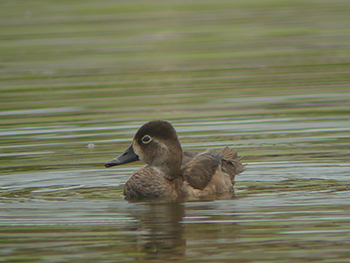
In autumn and winter, these ducks are often quite inconspicuous, but they can be recognized by the ring around their bill and a much less visible, lighter-coloured ring around their neck. The birds are native to North America, where they live on freshwater lakes and ponds. They aren’t found on Curaçao every year, and when they are, they’re usually in small numbers.
The Swainson’s trush or Catharus ustulatus
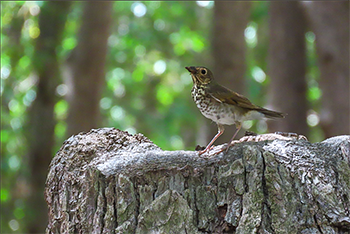
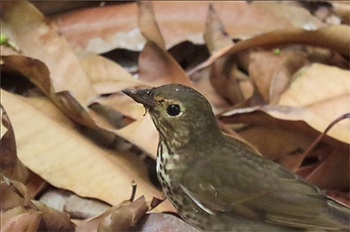
At the end of October 2023 local birder Rob Wellens registered the 3rd record for this very rare migratory species on the island of Klein Curaçao. It was exiting find with only 2 former records in total starting with the first sighting of one bird at Grote Knip on the 23rd of October 1951, observed bij K. H. Voous, and one bird found dead in Willemstad on April 23rd 1960 seen by B. de Jong. Between 1960 and 2023 no other specimens were found on the island of Curaçao making this sighting in October 2023 the first in 63 years. Now there is a 4th record of the Swainson’s Trush for Curaçao, this time recorded at Hofi Mango in Bandabou. The first time seen at this location: the end of October.
Multiple local birders have now managed to get photos and videos of the bird in question on multiple days. Photos in this post by local birder and photographer Rob Wellens.

Vogels spotten op Curaçao in November
November markeert normaal gesproken het einde van de massa’s trekvogels die door de vele habitats van het eiland trekken, maar dat betekent niet dat er geen verrassingen meer zullen zijn. De tijd heeft ons geleerd dat de maand november soms ongelooflijke waarnemingen van zeldzame en zelfs nieuwe soorten op het eiland oplevert. Het kan lonen om bepaalde gebieden op het eiland regelmatig te bezoeken om de vogeldiversiteit daar in de gaten te houden. Denk aan gebieden zoals het RAMSAR-gebied van de Muizenbergdam. Deze dam stroomt niet elk jaar helemaal vol, maar is afhankelijk van de hoeveelheid regen die er in het regenseizoen valt. Meestal bevat het gebied waterplassen die veel terrestrische vogels en steltlopers aantrekken. Als er in de directe omgeving meer regen valt, is de kans groot dat de dam volledig volloopt en verandert in een zoetwaterpoel die ook diverse watervogels aantrekt. Hetzelfde geldt voor andere dammen en geulen op het eiland.
Territoriumgevechten bij de witstaartbuizerden (Geranoaetus albicaudatus )

De Witstaartbuizerd is één van de zeldzaamste broedvogels van ons luchtruim en wordt door destructie van leefgebieden ook steeds zeldzamer op Curaçao. In deze eindejaars periode zullen er vaker territoriumgevechten te zien zijn tussen vooral volwassen vogels en jonge vogels die op zoek zijn naar een eigen territorium. De ouders zullen actief hun eigen kroost, dat reeds voor zichzelf kan zorgen, wegjagen uit het territorium om zo voldoende ruimte te hebben voor een volgend broedsel. Dat is essentieel, het territorium moet namelijk voldoende voedsel opleveren om het nieuwe nest voldoende te kunnen voeden. Op plekken waar deze vogels voorkomen is het dan ook zaak om goed op te letten tijdens het wandelen of je deze territoriumgevechten kunt observeren, het is absoluut de moeite waard om er de tijd voor te nemen. Een documentaire in live action.
Luid schreeuwend met hun karakteristieke hoge krijsen zullen de vogels om elkaar heen circelen en nep-aanvallen uitvoeren. Meestal is het de volwassen vogel, te herkennen aan de donkere kop en witte buik, die de schijnaanval uitvoert op de jongere vogel, die geheel donker gekleurd is. Maakt dit niet voldoende indruk op de jonge vogel om hem echt weg te jagen dan kunnen de schijnaanvallen omgezet worden in echte aanvallen waarbij de aanvaller met de poten en snavel de ander probeert te imponeren. Lukt dit, en vliegt de jonge vogel weg dan is het gevecht afgelopen. Lukt dit niet dan zal het gevecht doorgaan tot één van de twee het opgeeft. Is dat de volwassen vogel dan wordt het territorium overgenomen door de jongere vogel en zal het volwassen dier waarschijnlijk sterven.
Het is trouwens niet altijd het eigen kroost dat probeert het territorium van de ouders over te nemen. Meestal gaat het om jonge vogels van andere koppels die op zoek gaan naar een plek voor zichzelf en daarmee de gevechten veroorzaken. Overigens heeft de volwassen vogel op de foto net een prooi gevangen. Een hagedis zit vastgeklemd in de klauwen van de vogel.
Bijzondere vogelgasten
Het grootste deel van de herfsttrek, waarbij duizenden vogels uit Noord Amerika naar het warme zuiden vliegen en soms het eiland bezoeken, is achter de rug. Maar November is wel bij uitstek geschikt voor de komst van eenden. Die komen vaak als laatste aan. En ook hier blijven de meeste maar een paar dagen hangen en trekken dan weer verder. Slechts enkelen blijven overwinteren op het eiland. Naast deze eendensoorten zoals de Ringsnaveleend zijn er ook andere soorten trekvogels te vinden zoals de Citroenzanger en de snelste vogel ter wereld; de Slechtvalk.
De Slechtvalk of Falco peregrinus

De snelste vogel ter wereld is de Slechtvalk, en deze prachtige soort is ook op Curaçao te vinden in voornamelijk de wintermaanden. Te herkennen aan de gestroomlijnde vleugels en het extreem snel door de lucht klieven. Ze zijn vooral te spotten op plekken waar papegaaien en parkieten samenkomen om te overnachten. Of op plekken waar veel (stads) duiven te vinden zijn. Dat zijn ideale jachtlocaties voor deze geweldige dieren.
De Citroenzanger of Protonotaria citrea

Vliegensvlug en mensenschuw, de ideale combinatie om deze soort bijna nooit op de foto vast te kunnen leggen. Die dieren houden van zompige moerasachtige plekken en mangrovebosjes zijn dan ook favoriet. Je zou bijna niet denken dat de dieren met hun felgele kleurtje niet opvallen, maar het is blijkbaar de perfecte camouflage.
Ringsnaveleend of Aythya collaris

In de herfst en wintertijd zijn deze eendjes vaak vrij onopvallend van kleur maar te herkennen aan de ring om de snavel en een stuk minder zichtbare lichter gekleurde ring om de hals. De vogels komen oorspronkelijk uit Noord Amerika en leven daar op zoetwatermeren en poelen. Ze zijn niet elk jaar te vinden op Curaçao en als ze er zijn meestal in kleine aantallen.
De Dwerglijster


Eind oktober 2023 registreerde lokale vogelaar Rob Wellens de derde waarneming van deze zeer zeldzame trekvogel op het eiland Klein Curaçao. Het was een spannende vondst met in totaal slechts twee eerdere waarnemingen, te beginnen met de eerste waarneming van één vogel bij Grote Knip op 23 oktober 1951, waargenomen door K.H. Voous, en één dode vogel gevonden in Willemstad op 23 april 1960, gezien door B. de Jong. Tussen 1960 en 2023 werden er geen andere exemplaren gevonden op het eiland Curaçao, waardoor deze waarneming in oktober 2023 de eerste is in 63 jaar. Nu is er een vierde waarneming van de Swainsonlijster of Dwerglijster voor Curaçao, dit keer geregistreerd bij Hofi Mango in Bandabou. De eerste keer dat deze locatie werd gezien: eind oktober.
Meerdere lokale vogelaars zijn er inmiddels in geslaagd om op meerdere dagen foto’s en video’s van de betreffende vogel te maken. Foto’s van lokale vogelaar en fotograaf Rob Wellens.